Related Research Articles

Aquileia is an ancient Roman city in Italy, at the head of the Adriatic at the edge of the lagoons, about 10 kilometres (6 mi) from the sea, on the river Natiso, the course of which has changed somewhat since Roman times. Today, the city is small, but it was large and prominent in classical antiquity as one of the world's largest cities with a population of 100,000 in the 2nd century AD and is one of the main archaeological sites of northern Italy. In late antiquity the city was the first city in the Italian Peninsula to be sacked by Attila the Hun.

The Latin Patriarchate of Constantinople was an office established as a result of the Fourth Crusade and its conquest of Constantinople in 1204. It was a Roman Catholic replacement for the Eastern Orthodox Ecumenical Patriarchate of Constantinople and remained in the city until the reconquest of Constantinople by the Byzantines in 1261, whereupon it became a titular see. The office was abolished in 1964.
The Schism of the Three Chapters was a schism that affected Chalcedonian Christianity in Northern Italy lasting from 553 to 698 AD and in some areas to 715 AD, although the area out of communion with Rome contracted during that time. It was part of a larger Three-Chapter Controversy that affected the whole of Roman-Byzantine Christianity.
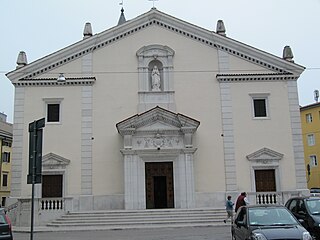
The Archdiocese of Gorizia (Latin: Archidioecesis Goritiensis is a Latin archdiocese of the Catholic Church in Italy. The archiepiscopal see of Gorizia was founded in 1751 when the Patriarchate of Aquileia was abolished, and its territory divided between two new dioceses, Udine and Gorizia. The diocese of Gorizia was suppressed in 1788 for the creation of the Diocese of Gradisca and re-established in 1791 as the Diocese of Gorizia e Gradisca. It was raised again to a metropolitan archdiocese in 1830.

This is a list of the Patriarchs of Grado.

The Patriarchate of Aquileia was an episcopal see and ecclesiastical province in northeastern Italy, originally centered in the ancient city of Aquileia, situated near the northern coast of the Adriatic Sea. It emerged in the 4th century as a metropolitan province, with jurisdiction over the Italian region of Venetia et Histria. In the second half of the 6th century, metropolitan bishops of Aquileia started to use the patriarchal title. Their residence was moved to Grado in 568, after the Lombard conquest of Aquileia. In 606, an internal schism occurred, and since that time there were two rival lines of Aquileian patriarchs: one in New Aquileia (Grado) with jurisdiction over the Byzantine-controlled coastal regions, and the other in Old Aquileia. The first line (Grado) continued until 1451, while the second line continued until 1751. Patriarchs of the second line were also feudal lords of the Patriarchal State of Aquileia. A number of Aquileian church councils were held during the late antiquity and throughout the middle ages. Today, it is an titular archiepiscopal see.

The Barbaro family was a patrician family of Venice. They were wealthy and influential and owned large estates in the Veneto above Treviso. Various members were noted as church leaders, diplomats, patrons of the arts, military commanders, philosophers, scholars, and scientists.

Saint Paulinus II was a priest, theologian, poet, and one of the most eminent scholars of the Carolingian Renaissance. From 787 to his death, he was the Patriarch of Aquileia. He participated in a number of synods which opposed Spanish Adoptionism and promoted both reforms and the adoption of the Filioque into the Nicene Creed. In addition, Paulinus arranged for the peaceful Christianisation of the Avars and the alpine Slavs in the territory of the Aquileian patriarchate. For this, he is also known as the apostle of the Slovenes.

The Diocese of Vittorio Veneto is a Latin diocese of the Catholic Church in northern Italy, with its see in Vittorio Veneto. It was historically known as Diocese of Ceneda, the name being changed in 1939.

The Diocese of Concordia-Pordenone is a Latin diocese of the Catholic Church situated in northeastern Italy, at the northern end of the Adriatic Sea, between Venice and Udine. Since 1818, Concordia Veneta, has been a suffragan of the Archdiocese of Venice. Bishop Andrea Casasola attended the Provincial Council of the Provincia Veneta in October 1859 as a suffragan of the Patriarch of Venice, Cardinal Giuseppe Luigi Trevisanato. The name of the diocese was changed to its present form in 1971.
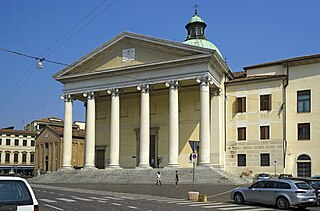
The Diocese of Treviso is Latin Church ecclesiastical territory or diocese of the Catholic Church in the Veneto, Italy. It is a suffragan diocese in the ecclesiastical province of the metropolitan Patriarchate of Venice.

Lodovico della Torre was Patriarch of Aquileia from 1359 until 1365.

Nicolaus of Luxemburg was Patriarch of Aquileia from 1350 until 1358.

The Patria del Friuli was the territory under the temporal rule of the Patriarch of Aquileia and one of the ecclesiastical states of the Holy Roman Empire. In 1420, the Republic of Venice acquired it, but it continued to be ruled for some time under its own laws and customs.

Francesco Barbaro (1546–1616) was a Venetian aristocrat, ambassador and, from 1593 to his death, Patriarch of Aquileia.
Paolo Bisanti was Bishop of Kotor and later Vicar of the Patriarchate of Aquileia where he played an important role in the Catholic reform.
This is an alphabetical index of people, places, things, and concepts related to or originating from the Republic of Venice. Feel free to add more, and create missing pages.
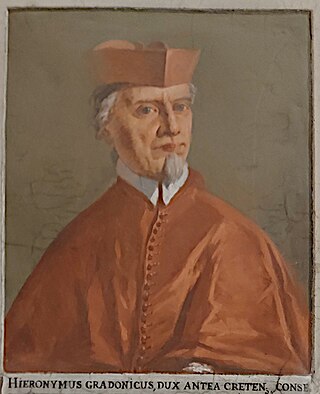
Gerolamo Gradenigo was Patriarchate of Aquileia from 1656 to 1657.
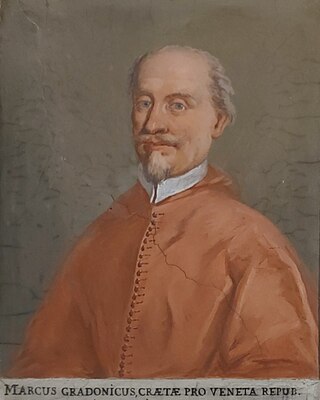
Marco Gradenigo was Duke of Crete from 1627 to 1629, and later Patriarch of Aquileia to his death in 1656.
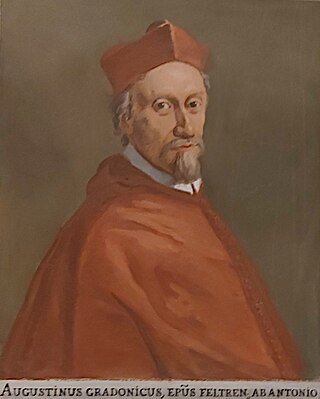
Agostino Gradenigo was bishop of Feltre from 1610 to 1629, and later Patriarch of Aquileia to his death in 1629.
References
- ↑ Saint Hilary of Aquileia » Saints.SQPN.com
- 1 2 3 4 5 6 7 8 9 10 11 12 13 14 15 16 17 18 19 20 21 22 23 24 25 26 27 28 29 30 31 32 33 34 35 36 37 38 39 40 41 42 43 44 45 46 47 48 49 50 51 52 53 54 55 56 Chow, Gabriel. "The Patriarchate of Aquileia". GCatholic.org. Retrieved February 14, 2010.
- ↑ Sommer, Petr; Třeštík, Dušan; Žemlička, Josef (2009). Přemyslovci. Budování českého státu (in Czech). a kol. Praha: Nakladatelství Lidové noviny. p. 555. ISBN 978-80-7106-352-0.
- ↑ Eduard Traversa, "Ottobono de' Razzi ( 1302-1315). Ein weiterer Beitrag zur Geschichte des Patriachates von Aquileja." (in German and Latin). In: Jahresbericht über das k. k. Staatsgymnasium im VIII. Bezirke Wiens, Vol. 61 (1911); Vol. 62 (Wien 1912); Vol. 63 (Wien: E. Kainz vorm. J. B. Wallishausser 1913), pp. 57-87.
- ↑ "The Patriarchate of Aquileia" . Retrieved 2010-02-14.; Marco Innocenti (2001). "Nikolaus von Luxemburg". In Bautz, Traugott (ed.). Biographisch-Bibliographisches Kirchenlexikon (BBKL) (in German). Vol. 18. Herzberg: Bautz. cols. 1038–1044. ISBN 3-88309-086-7.